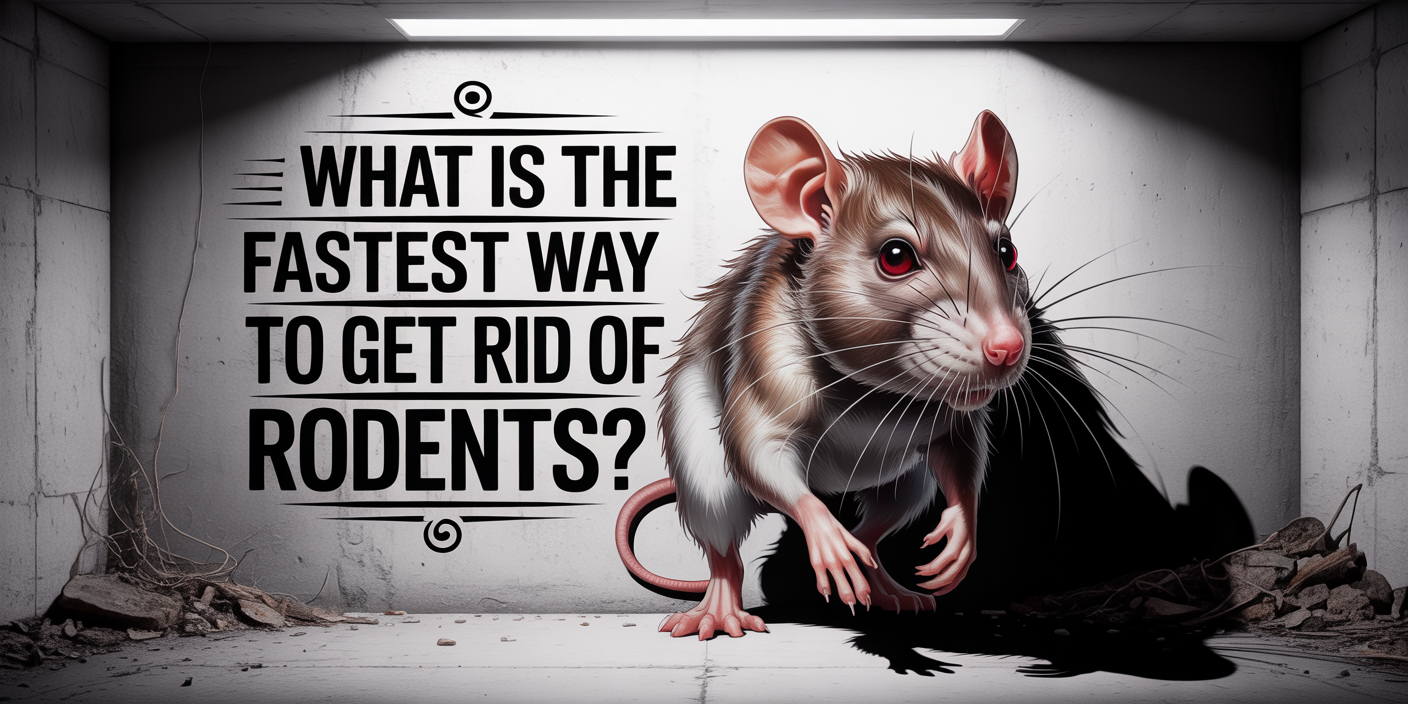The fastest way to get rid of rodents is to combine snap traps or bait stations with immediate sealing of entry points and removal of food sources. Acting quickly with the right tools stops the infestation from spreading and gives you control within days.
Rodents don’t waste time—and neither should you. Whether it’s rats in the attic or mice in the pantry, the longer they stay, the more damage they cause and the faster they multiply. In this guide, we’ll walk you through the fastest ways to get rid of rodents, from quick DIY fixes to professional help that gets the job done right the first time.
Why Are Rodents So Hard to Eliminate Quickly?
Rapid Breeding and Stealth Behavior
Rodents reproduce at an alarming rate—a single pair of mice can produce dozens of offspring in just a couple of months. By the time you notice one or two, there’s a good chance a whole nest is already active behind your walls, attic, or cabinets.
Their ability to hide in tiny spaces makes early detection tough. Mice can squeeze through holes as small as a dime, while rats prefer tight, undisturbed areas where traps rarely reach without strategic placement.
Nocturnal Patterns and Adaptability
Most rodents are active at night, which means you might not spot them right away unless you’re paying attention to droppings, gnaw marks, or scratching sounds after dark. This makes daytime inspection tricky and allows infestations to grow unnoticed.
They’re also surprisingly smart and cautious—especially rats. Once they associate traps or bait with danger, they’ll actively avoid them, making elimination even harder without adjusting tactics.
What Is the Fastest Way to Get Rid of Rodents?
Snap Traps and Bait Stations
Snap traps remain one of the quickest and most effective tools for killing rodents on contact. When placed correctly along runways, behind appliances, or near droppings, they can start reducing the population within hours.
Bait stations are ideal for targeting rodents that avoid open traps, especially in larger or multi-entry infestations. They contain slow-acting poison that rodents carry back to their nests, helping eliminate multiple pests at once while keeping the bait secure from pets and children.
Professional Pest Control
If rodents have already made it into walls, ceilings, or inaccessible areas, professional pest control is your fastest route to full elimination. Licensed technicians can identify entry points, nesting spots, and runways that most homeowners overlook.
They also use industrial-grade solutions like tracking powders, CO2 traps, and EPA-regulated rodenticides that aren’t available in stores. When speed and thoroughness matter, a trained crew can get the job done in a fraction of the time it takes with guesswork.
What Are Emergency Rodent Control Tips You Can Do Now?
Seal Entry Points Immediately
Use steel wool, copper mesh, or hardware cloth to block gaps around pipes, vents, baseboards, and crawlspaces the moment you spot activity. Even a pencil-wide space lets a mouse squeeze through, so aim for an airtight seal everywhere light or air leaks in.
Inspect door sweeps, garage seals, and attic louvers for wear that rodents can exploit. Closing these openings stops new pests from entering while you tackle those already inside, shortening the time to full elimination.
Eliminate Food and Water Sources
Sweep up crumbs, store pantry staples in airtight containers, and empty pet bowls at night to remove easy meals. Rodents gravitate toward accessible calories, so a spotless kitchen immediately disrupts their nightly routine.
Fix dripping faucets and leaking pipes to cut off moisture that can keep rodents alive for weeks. A dry, food-secure environment forces them to seek baited traps or move on.
Deploy Multiple Traps Quickly
Set snap traps or bait stations every few feet along walls, behind appliances, and near droppings for maximum coverage. A high trap density increases the odds of first-night captures and prevents rodents from mapping a safe path.
Pre-bait traps (place bait without setting them) for one night to build trust, then activate them the next evening. This simple trick can double your catch rate and speed up the initial knockdown phase.
Declutter and Sanitize Nesting Areas
Remove cardboard boxes, old newspapers, and piles of clothing where rodents build nests. Less clutter means fewer hiding spots, making your traps and bait far more effective.
Vacuum droppings and disinfect surfaces with a bleach solution to erase pheromone trails that attract other rodents. A clean, organized space also makes it easier to monitor new activity and spot fresh signs early.
Do Natural Rodent Repellents Work?
Peppermint Oil, Ultrasonic Devices, and DIY Mixes
Natural repellents like peppermint oil, clove oil, or cayenne pepper sprays are often recommended as quick deterrents. These strong-smelling substances may temporarily confuse or repel rodents from entry points or specific areas like under sinks or behind stoves.
However, in active infestations, these solutions rarely reach nesting spots or deter hungry rodents for long. They’re best used as complementary tools—not standalone fixes—and should always be paired with sealing, trapping, or professional removal.
Limitations of “Quick Fix” Solutions
Ultrasonic devices are widely sold as non-toxic repellents, but their effectiveness is mixed at best. Rodents often get used to the noise, and the sound doesn’t travel well through walls or furniture, leaving many hiding places untouched.
DIY mixes like vinegar sprays, mothballs, or ammonia can create short-term discomfort but don’t remove the core problem: food, water, and shelter. If rodents are already inside, these quick fixes may delay them—but won’t stop them.
What If You Still Hear Rodents After Treatment?
Common Mistakes That Delay Results
If you’re still hearing scratching, squeaking, or movement after a few days, chances are something was missed. Incomplete sealing, poorly placed traps, or using too few traps for the size of the infestation are the most common culprits.
Rodents are excellent at hiding and avoiding danger, especially if traps aren’t placed along their regular travel paths. Double-check dark corners, attic beams, and hidden crawlspaces—you might still have unaddressed entry points or hidden nests.
When to Call for Professional Help
If signs of activity continue after 48 to 72 hours of treatment, it’s time to bring in professionals. Licensed pest control or wildlife removal experts can locate nests inside walls, follow urine trails, and identify subtle rodent damage the average homeowner may miss.
They’ll also create a customized plan with better-grade equipment, sealing work, and monitoring to stop the problem at the source. It’s not just about speed—it’s about making sure rodents are gone for good.
Call AAAC Wildlife Removal for Fast, Reliable Rodent Control
If you’re hearing scratching in the walls or spotting droppings in your kitchen, don’t wait for things to get worse. At AAAC Wildlife Removal, we specialize in fast-response rodent control that targets the root of the problem—not just the symptoms.
Our expert team handles everything from inspections and humane removal to sealing entry points and setting up long-term prevention. Whether you’re dealing with rats, mice, or an entire hidden nest, we’ll help you take back your home—quickly, safely, and for good. Call now to schedule a same-day inspection.
Conclusion
Getting rid of rodents fast is possible—but only if you act quickly and tackle every angle at once. That means trapping aggressively, sealing up every tiny entry point, and cutting off access to food and water from day one.
Still, speed alone won’t guarantee lasting results. Long-term success comes from consistent maintenance, vigilance, and knowing when to bring in the pros. With the right plan in place, you can stop rodents in their tracks—and make sure they don’t come back.




